
Since the rise of the internet, digital advertising has grown up to become the preferred choice of marketers and advertisers, leaving the so-called traditional marketing channels aside.
However, bus advertising remains as effective as ever before and still plays an important role that should not be disregarded.
People spend 70% of their time outdoors
Statistic – Fact
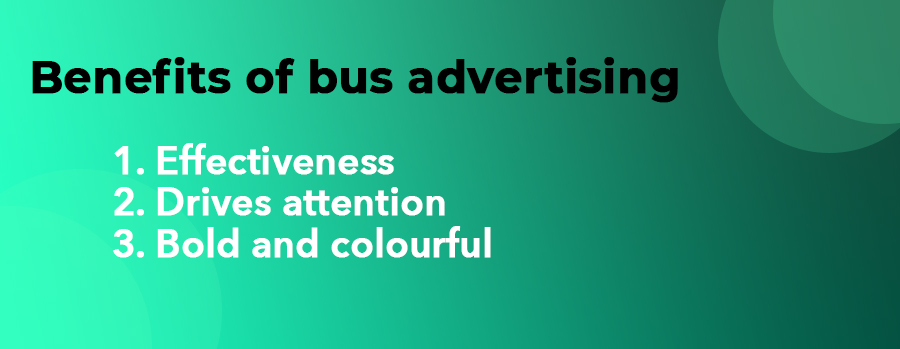
- 1. What is Bus advertising?
- 2. Types of bus advertising
- 3. Bus advertising statistics
- 4. Why bus advertising
- 5. How does bus advertising work
- 6. Most creative ad examples
- 7. Top Media Advertising
1. What is Bus advertising?
Bus advertising belongs to the so-called OOH section of advertising (out-of-home) which refers to any promotional materials that aim to catch customers outdoors or when they are not at home.
There are multiple OOH advertising possibilities such as billboards, street furniture, stadiums…
Bus advertising descends from the same tactics used in tramcars in the early 20th century. Since then it has not seen many changes, from hand-painted banners to printed ones, however, today bus advertising is seeing a bigger change: digital banners on the bus.
The digitalization of bus advertising would involve cheaper production costs, wider control over times and campaign length and more flexibility on content but soon it will allow video banners on the bus.
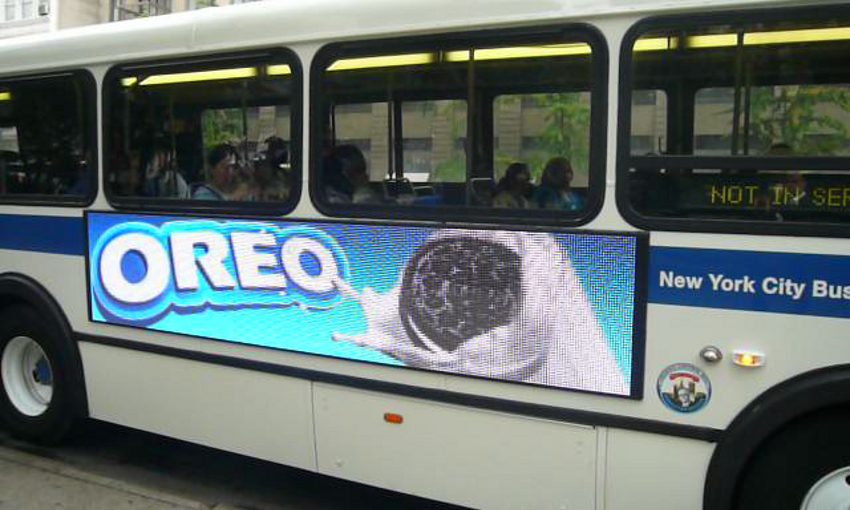
2. Types of bus advertising
There are three main types of bus advertising: tickets, interiors and exteriors. You could probably place an ad anywhere on a bus from ceiling, seats to even doors.
Either way, all of them will fall within any of these three types which we will explore in detail.
However, in this article, I will not discuss bus shelter and stops as a category of bus advertising as it is most often included within the street furniture advertising category.
1. Bus tickets
Bus tickets are probably the last thing it comes to one’s mind when thinking of bus advertising, however, it has been used for long and it can be a very cost-effective way of advertising.
On one hand, its reach is much more limited compared to interiors and especially exterior which can reach up to 30 million in the United Kingdom a week.
This kind of advertising is usually printed on the back of the tickets. Usually, the entire paper roll has the advertiser’s banner and tickets will be printed on the front side.
As our society goes paperless, this sort of advertising might eventually disappear.
2. Bus interiors
Bus interior banners are more common and they can be found almost anywhere inside the bus but they are most commonly placed in the back of the seat and overhead ceiling and corners between the walls.
Along with this, quite often we can see ad displayed on the television systems inside the bus. These were initially installed to show passengers information about the service route and destination but they were eventually employed to place ads too.

3. Exteriors
Adverts are most often found as rectangular motifs on the side or front of a bus. These are usually attached on the outside of the bus and come in multiple formats and can be printed on boards, placard or digital screens.
There are mainly five different formats of exterior bus ads we see often:
- T-sides – as its name suggests are ads in the form of T and mainly located on the side of the bus.
- Supersides – cover the entire side as a form of strip.
- Streetliners – are strips located below the window level of the bus and can go from the back to the front of the vehicle.
- Rears & Mega Rears (Bus backs) – located at the back of the ad.
- Full Wraps – consist of an ad covering the entire advertising space of a bus such as the front, ceiling, back and sides.
As exterior bus advertising is so popular and there are so many options, below I have listed all the types of exterior bus banners.
Digital ad bus
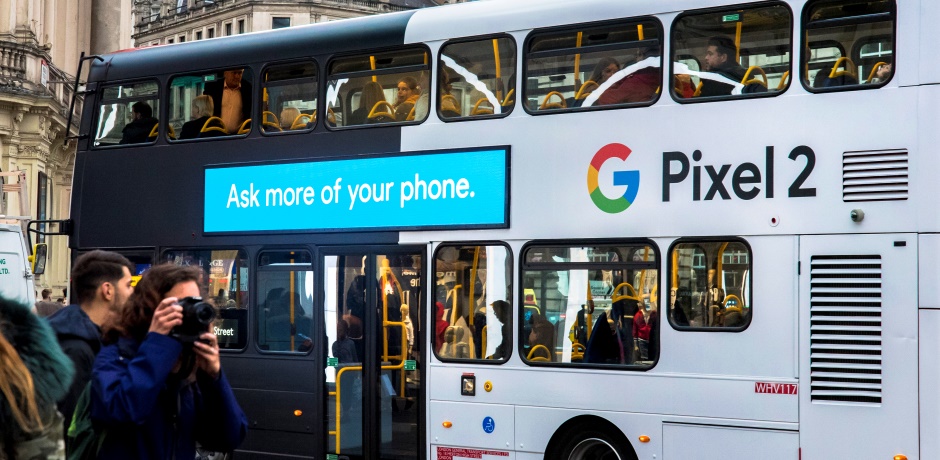
Mega rear ad bus
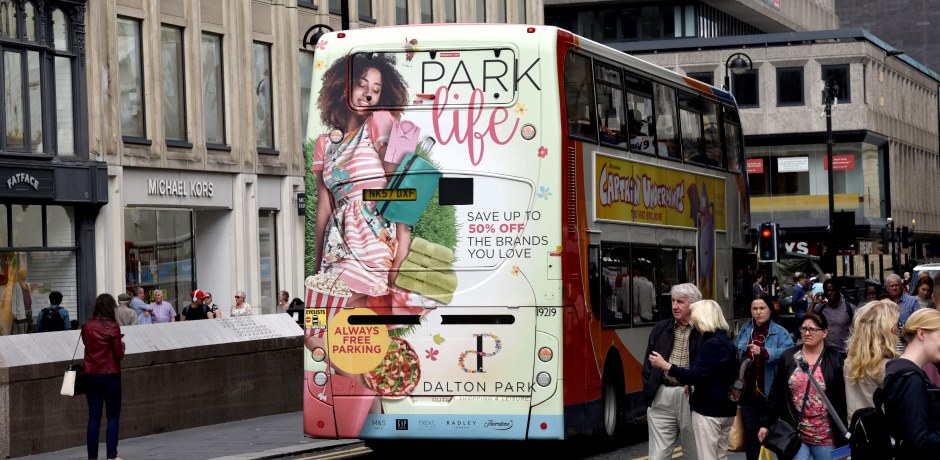
Mega T-side ad bus
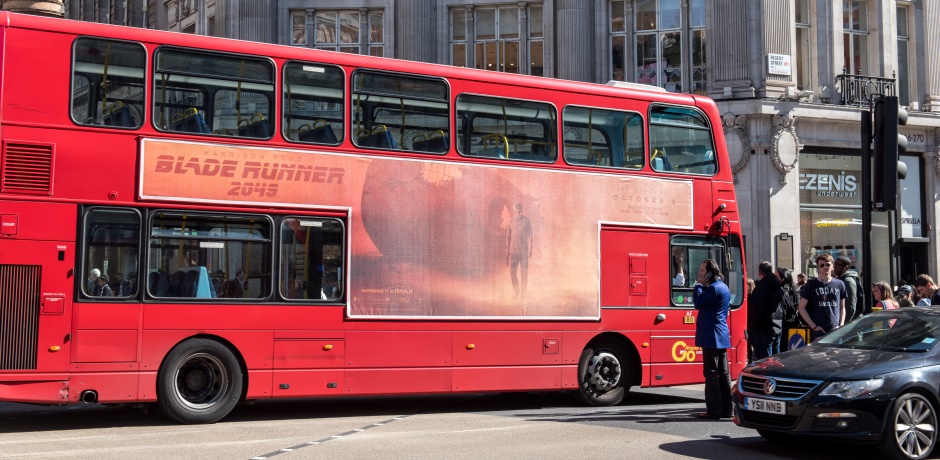
Rear ad bus
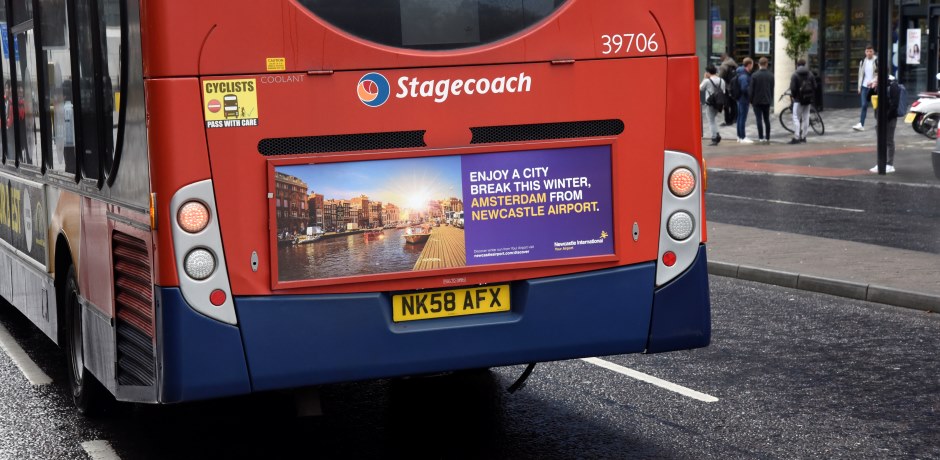
Rear ad bus
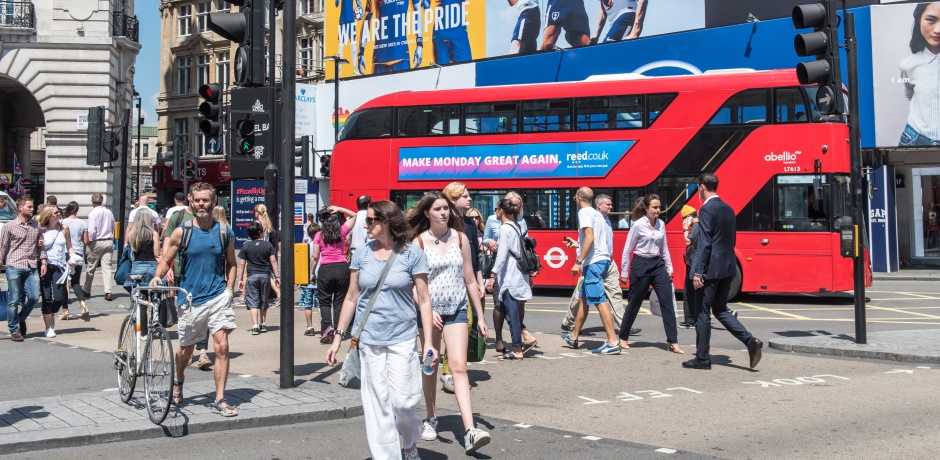
Superside ad bus
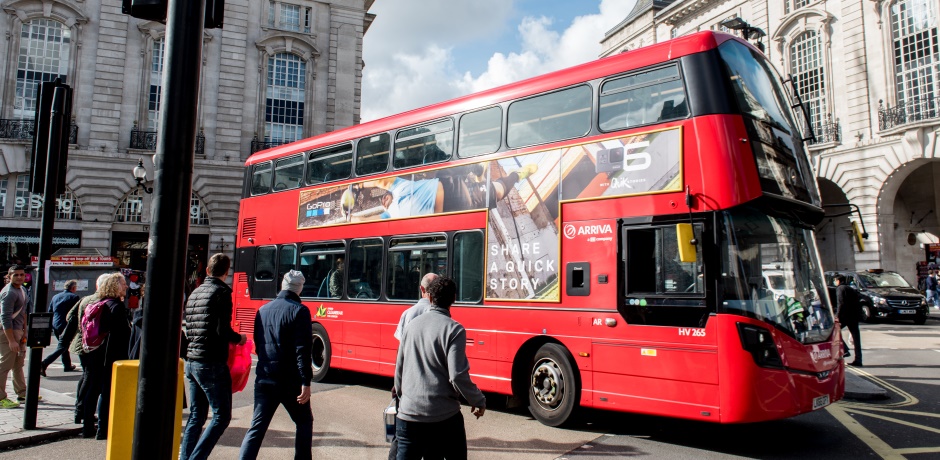
T-side ad bus

Wrapped ad bus
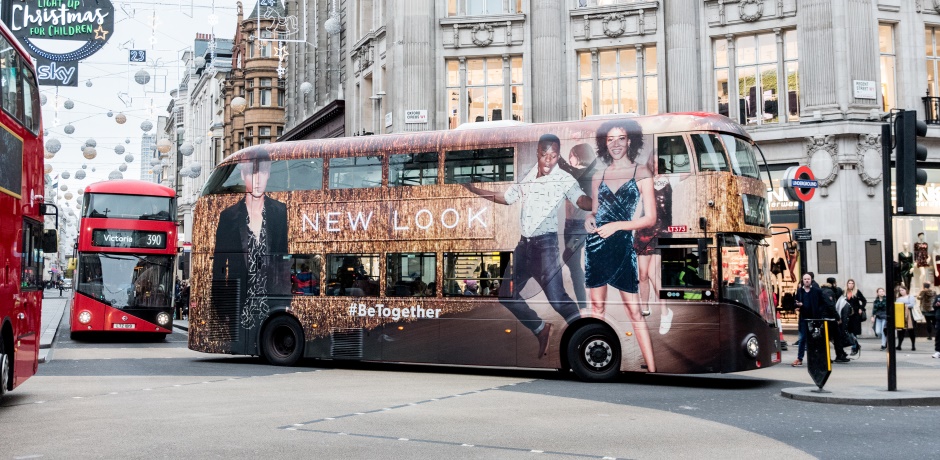
Streetliner ad bus
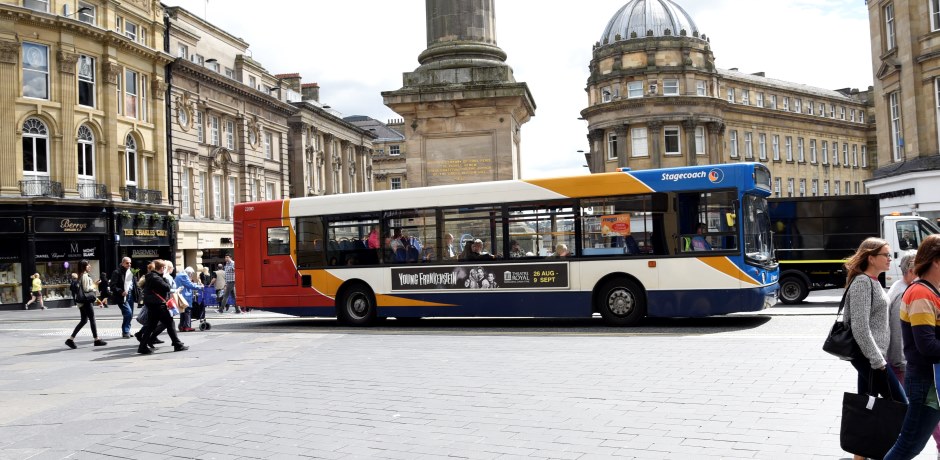
3. Bus advertising statistics
Bus advertising can be very effective to promote your company or product. Depending on the nature of your business and your budget, you could choose among several ad formats.
Many small businesses tend to go for small back rear ads which are generally more affordable. However, when it comes to putting your brand out there, anything is better than nothing.
And ultimately a creative ad can deliver great results either way.
If you are deciding to advertise on buses, you should at least have a good knowledge of your market audience, competitors and how bus advertising can eventually benefit your company.
Below I have listed some of the most relevant bus advertising statistics to help you plan or optimize your bus advertising campaign.

#1 – 30 million people see a banner on a bus each week in the United Kingdom (TGI)
Statistic – Fact
At first sight, many could think that bus advertising is boring as opposed to digital advertising methods which offer immediate feedback and almost real time results, however bus advertising reach remain very extensive and surprisingly effective.
#2 – OOH advertising reaches 98% of the UK population (Route)
Statistic – Fact
Bus advertising could bring higher results when it comes to brand awareness, for example, unlike digital banners, adverts on buses are much harder to miss and usually while browsing online we are being distracted multiple times.
However while walking down the street, banners on buses are more perceivable.
#3 – 61% of consumers had seen ads on buses within the last 7 days (TGI)
Statistic – Fact
Ad buses are frequently used by film advertising partners that usually rent slots for the first few weeks of a movie being released on theatres. Those experienced advertising executive excel at understanding the power of bus banner and how effective still are.
#4 – 29% of adults use buses to commute for a minimum of an hour a week (TGI)
Statistic – Fact
In some cities like London, commuting time can be unbelievably long. This is probably the reason why transit advertising is more relevant in metropolitan areas. Even so, most adults are exposed to ad buses for at least an hour a week.
#5 – 83% of people say to remember OOH advertising they saw within the last 30 min of going shopping (Outsmart, Window of Influence, 2011)
Statistic – Fact
#6 – Most UK adults spend 70% of their time out-of-home (Source: TGI)
Statistic – Fact
#7 – 35% of those aged between 25 and 34 have actually seen advertisements either inside or outside within the last 7 days. (Source: TGI)
Statistic – Fact

4. Why bus advertising
Bus advertising can be both very effective and affordable. Bus advertising is one of the most cost-effective advertising channels. Movies and the Hollywood industry, in general, is one of the biggest spenders on transit advertising and we can often ads covered on the latest blockbuster films.
Similarly, it can be very convenient for small and medium-sized businesses which want to increase brand awareness locally as it is very easy for an agency to place ads on certain bus routes.
For example, local dentists or lawyers could increase their leads by leveraging bus advertising.
- Buses can reach passers-by, passengers as well as drivers and motorist on roads
- Buses are visually unavoidable unlike many digital banners
- It is hard to ignore and reaches over 80% of the population in a week
- Unlike other media, such as radio, internet and television, it can´t be turned off
- Big, bold and colourful ads that drive attention
- You have exclusivity in your space
- It reaches a varied audience
- Unlike digital banners, bus ads are considered by consumers as more reputable
- It offers the flexibility of ad size and location.

5. How does bus advertising work
It is always best to use an advertising agency to help you plan your advertising campaign and create an effective buying plan for your showing times and locations.
There are several factors that can influence a bus advertising campaign but mainly there are three: location, time of year and format.
As we saw above there are multiple bus ad formats and depending on your budget and nature of your business, some would be more cost-effective than others.
Bus routes are a contributing factor in the final price of your ad as some bus routes are busier and buses travel through areas where footfall is higher. These will eventually come at a higher price.
By conducting a needs analysis with each client, we help figure out the goal of your outdoor advertising campaign and then work to locate the right places to advertise.
Finding the right bus route to ensure exposure to your target audience will help your outdoor advertising piece reach its full potential.
1. Time – It takes a crucial role in your campaign success. Choosing a short campaign could make a very little impact on your audience and eventually return no lasting or solid results.
2. Route – If you are a local business, you might want to choose a bus route that is closer to your business, but if your company reaches nationwide, you will ultimately choose those routes that are the busiest so you can reach to a much larger audience.
3. Format – Depending on the size of your ad, the cost of your campaign will be either higher or smaller. For small businesses, a small banner located inside the bus could be the best choice. However for movies, for example, large T-sides are the commonest option.
6. Most creative ad examples
The video below contains a collection of the most creative and effective bus ads to inspire your next campaign. The video is under five minute long and it is worth every second as I am very confident it will spark your imagination.
7. Top Media Advertising
At Top Media Advertising, we can help plan and create your bus advertising campaign or just simply facilitate your buying process from media companies.
If you have any questions regarding bus advertising, please get in touch with us on our contact page or click on the envelope icon on the bottom right corner and a contact form will pop up.
Sources:
https://outdoor.global.com/uk/our-products/road/bus-advertising
https://www.outsmart.org.uk/resources/last-window-influence
- What is Bus Advertising?
Bus advertising belongs to the so-called OOH section of advertising (out-of-home) which refers to any promotional materials that aim to catch customers outdoors or when they are not at home.
- Bus advertising dimensions
There are quite a few different bus ad format: T-sides , Supersides, Streetliners, Rears & Mega Rears (Bus backs), Full Wraps.

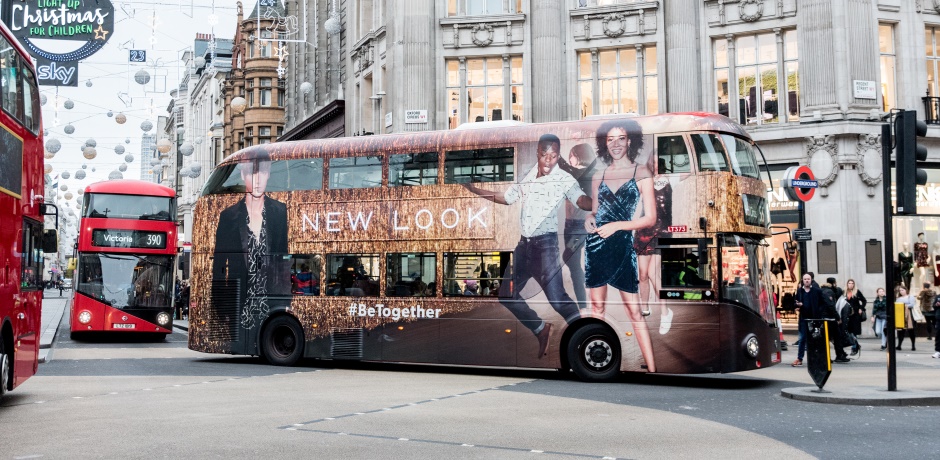



Like!! I blog frequently and I really thank you for your content. The article has truly peaked my interest.